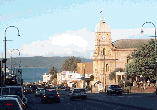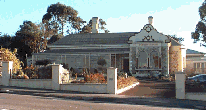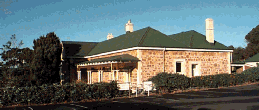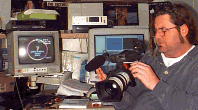IT Industry Attraction Project
Information Technology Enterprise in the Great
Southern Region of Western Australia
An IT Industry Consultancy for the Great Southern
Region Development Commission
Visit May-June 2000
Introduction
This is an informal travelogue style report, as part of phase
one of the study to optimise IT industry attraction potential
through initial market assessments.
As explained in the Background to the
Study, is not intended to be an academic, or pure research,
study. The project aims to attract call/contact centres, and other
small to medium size IT enterprises to the Great Southern region of
Western Australia. Therefore each phase of the project will report
lessons learnt on attraction of IT projects in other areas. It will
highlight aspects of the region that would be attractive to those
intending to set up a call/contact centre or other small to medium
size IT enterprises.
This document is a work-in-progress and as such will change
as it is developed. Comments, corrections and contributions are
welcome.
A visit was made to the Great Southern Region of West Australia,
May 29 to 2 June 2000. Before the trip a request for information was
issued to members of the IT profession and others interested in
information industry matters via the Internet:
Subject: Net Traveller to Australia's Great
Southern Region 29 May to 2 June
I wrote Sat, 19 Mar 1994 09:22:37 GMT (was: "Hi-tech
tourist in Europe in April"):
> Can you suggest any hi-tech related tourist
activities for an Australian
> computer person in Europe in
April? ... I get a bit bored on holiday
>looking at historic
buildings and waterfalls...
My next visit will be to the Great Southern Region of
West Australia, May 29 to 2 June 2000. As with previous net travels I
would be interested in suggestions as to what high technology aspects
of the region to look at (as well as tourist attractions) and who to
visit.
This is the latest in what has turned into a six year
odyssey, including visits to centres of learning and involvement with
the Internet in military exercises. This is described in my book "Net
Traveller - Exploring the Networked Nation":
http://www.tomw.net.au/nt
This trip is part of a project to attract call/contact
centres, and other small to medium size IT enterprises for the Great
Southern Region Development Commission. See:
http://www.tomw.net.au/gsr
The Great Southern region is an hour by plane from
Perth. It includes the historic whaling town of Albany; the wines and
wildflowers of Mt Barker; the gourmet foods, forests and art of
Denmark; and the rural farm areas and national parks further north.
See the web site for links to tourist information.
In terms of IT, the region already hosts a Telstra
Call Centre with 40 staff, located in the town of Katanning. Design
Correlations is an Australian owned company located in Albany, which
specialises in making Numerically Controlled (NC) machinery and in
particular a NC Plasma Cutter of which over thirty are in operation
throughout Australia, New Zealand and Indonesia. Details are on the
web site and other hi-tech businesses in the region might like to
contact me for a visit and to be added.
On my way to the region (Perth Monday 29 May) I will
be discussing the project with state government officials and talking
about recent work on e-business for the Federal Government:
http://about.business.gov.au/ipp/ipga.html
There is the opportunity to stop off in Perth on the
way back (Friday 2 June), if corporate or government people would
like to discuss this or other projects.
Schedule
|
Sunday 28 May |
Perth |
11.30pm |
Arrive |
|
Monday 29 May |
|
morning |
Research call centres and IT in WA at the State Library |
|
|
lunch |
Working lunch with staff from Major Projects, Department
of Commerce and Trade, Government of Western Australia. |
|
To Albany |
evening |
 Collect
rental car and check into a motel in Albany Collect
rental car and check into a motel in Albany
|
|
Tuesday 30 May |
Albany |
9am |
 Meet
project officer: Mark
Pitts-Hill, Great Southern Development Commission, Pyrmont
House, 110 Serpentine Road, Albany Meet
project officer: Mark
Pitts-Hill, Great Southern Development Commission, Pyrmont
House, 110 Serpentine Road, Albany
|
|
|
11am |
Alan
Dodds, IT Manager and Tutor in IT, University
of WA Albany centre, Old Headmatser's House, 85 Serpitine
Road, Albany WA 6330  
|
|
|
2pm |
 Gill
Sellar, Manager, Albany
Gateway, 70 Frederick House, Frederick Street, Albany WA 6330 Gill
Sellar, Manager, Albany
Gateway, 70 Frederick House, Frederick Street, Albany WA 6330
|
|
|
3pm |
Project Steering Committee, Great Southern Development
Commission |
|
|
4pm |
Kristina Fleming,
centre Manager, South Coast Regional Information Centre, 444
Albany Highway, WA 6330 |
|
Wednesday 31 May |
Albany |
10am |
  Brad
Barber, Multimedia Coordinator & John
Cecil, Regional Program manager, ABC
Radio South Coast, 2 St. Emilie Way, Albany WA, 6330 Brad
Barber, Multimedia Coordinator & John
Cecil, Regional Program manager, ABC
Radio South Coast, 2 St. Emilie Way, Albany WA, 6330
|
|
|
Afternoon |
 John
Beaton, Project Manager, Geo
Task (Australia), Suite Six, 57-59 Lockyer Ave, Albany WA 6330 John
Beaton, Project Manager, Geo
Task (Australia), Suite Six, 57-59 Lockyer Ave, Albany WA 6330
|
|
Thursday 1 June |
Kojonup |
Morning |
Manager, Kojonup Telecentre |
|
Katanning |
Afternoon |
Manager, Katanning Regional
Telecentre, Old Library Building, Austral Terrace, Katanning
WA.
|
|
|
Lunchtime |
Manager, Katanning Call Centre |
|
Queensland (virtually) |
Evening |
Virtual
Cultures Tutorial, School
of Media and Journalism, Queensland University of Technology |
|
Friday 2 June |
Perth |
10.30am |
Meet with Australian
Computer Society WA Branch executive, 342 Albany Highway,
Victoria Park |
|
|
1pm |
Interview with Verity James, ABC
Radio Perth |
|
|
2pm |
Web streaming
interview recorded by John Bowskill, Streamtime |
|
|
5pm |
Glenn Hakinson, Dow
Digital |
|
Saturday 3 June |
Depart Perth |
0.45am |
|
Notes
Research call centres and IT in WA at the State
Library
Having arrived late Sunday night in Perth from Canberra, I had a
leisurely breakfast in the city centre and then walked to the State
Library of Western Australia. There I spent the morning researching
local work on call centre attraction in Western Australia. The most
useful item found was a booklet produced by the Department
of Commerce and Trade:
"Western Australia calling
- a guide to the development of call centres in Western Australia",
Commerce and Trade, Government of Western Australia. Perth, W.A.
(DCT, 1998).
This is a useful indicator of what the Government sees as
attractive for call centres operators. It has glossy photographs of
culturally diverse happy call centre workers, cityscapes and modern
office facilities. One pitch is to differentiate Western Australia
from the eastern states, by pointing out it is in a similar time zone
as much of Asia, unlike the east cost of Australia. Lower living
costs and claiming a stronger political, economic and social
affiliation to Asia is also emphasised.
Claims that are probably universal for this sort of promotion are
also made:
- State of the art IT and telecommunications infrastructure
- Competitively priced office accommodation
- Highly skilled IT workforce
Low staff turnover
The booklet first promotes WA overall, then Perth and then
regional areas. There is a pocket in the back of the book with loose
sheets for each region. As with other regions, the Great Southern
Region emphasises available infrastructure, workforce, low costs and
pleasant lifestyle.
One failing in these brochures is that they use photographs of
natural attractions, not commercial facilities. This gives the
impression of undeveloped regions lacking infrastructure and
commerce. Some photos of the city centres and inside local IT
facilities would give a better impression.
However, the features of this material are largely irrelevant as
most people looking to set up business will never get to see the
material. The brochures are only available on paper and the
distribution is limited. Having found the document in the WA Library,
I then had to submit a stack request and wait for it to be retrieved.
The document is not open for casual browsing.
The Department of Commerce and Trade will provide a copy of the
document on request, but becoming aware of the document's existence
would be difficult for a potential investor.
Obviously this booklet and any other material
promoting WA as an IT centre needs to be on the web. The full text
should be on-line, the name of the document and where to request a
paper copy. In this way the document can be found by people doing web
searches, who had not been aware of it, or of WA.
Department of Commerce and Trade
After some research, I felt better equipped for a working lunch
with staff from the Major Projects area of the Department
of Commerce and Trade of Western Australia.
Like much of the WA State Government's head offices, it is on St
George's Terrace, near the Swan River. The meeting room, high in the
building, had a distracting attractive panoramic view of the Swan
River.
The half a dozen staff in attendance were from the areas looking
at attracting call centres (who produced the booklet discussed
above), as well as internal IT and business and areas attracting
education industry. I did a lot of talking and not much eating. ;-)
Issues were:
On the face of it, only the second point
appears directly related to the project. The discussion of e-commerce
was largely about a separate project, which I was undertaking for the
Federal Government's Business
Entry Point, on Internet
Payments (BEP, 2000). Developments in
education concerned my activities as a Visiting Fellow at the
Department of Computer Science at
The Australian National University.
However, e-commerce is directly relevant to attracting IT business
to regional areas. This is a key technology for companies outside
traditional commercial centres can compete. Distance is irrelevant,
if products and services can be promoted, sold and serviced on-line.
While reading the business and IT sections of a newspaper would
suggest that all the problems in e-commerce have been solved and it
is just a matter of implementation, this is far from the reality.
Education is also very relevant to attracting IT companies to an
area. While the IT industry needs few natural resources, it does need
trained staff. One of the attractors is therefore available training
facilities. Supporting the level of training facilities is difficult
for a regional area, particularly at the tertiary level, required.
However, I found that the Great Southern Region is one of the leaders
in solving this problem (see University of WA Albany centre
below).
Some points that came out of the discussion with Departmental
staff were:
Albany
 My
first introduction to different atmosphere of the region was on the
flight (approximately one hour) from Perth to Albany
(the main town, with a population of just over 20,000). This is a
shuttle flight with some regular business commuters. Even before
boarding the aircraft I had introduced myself to a local business
person, who then pointed out the head of the Great Southern Region
Development Corporation (my client) a few seats in front. This is a
useful aspect of doing business in a regional area that is not
pointed out in the brochures.
My
first introduction to different atmosphere of the region was on the
flight (approximately one hour) from Perth to Albany
(the main town, with a population of just over 20,000). This is a
shuttle flight with some regular business commuters. Even before
boarding the aircraft I had introduced myself to a local business
person, who then pointed out the head of the Great Southern Region
Development Corporation (my client) a few seats in front. This is a
useful aspect of doing business in a regional area that is not
pointed out in the brochures.
At the airport I collected a car and made the short drive to the
town and my motel. IT may seem trivial to point this out, but the
fact a hire car can be booked at the airport can be an important
point for business travellers.
To keep the locals happy when visiting Albany, pronouncing the
name of the town is important. I kept calling it "all-bann-eee",
which annoyed the locals, who call it "al-bun-nee".
Great Southern Development Commission
 The
first meeting in the region was with the project officer, Mark
Pitts-Hill at the offices of the Great Southern Development
Commission in Pyrmont House, 110 Serpentine Road. While I had talked
by telephone and exchanged much e-mail with Mark, this was the first
time I had met him. This is one of the strange aspects that
telecommunications introduces into business.
The
first meeting in the region was with the project officer, Mark
Pitts-Hill at the offices of the Great Southern Development
Commission in Pyrmont House, 110 Serpentine Road. While I had talked
by telephone and exchanged much e-mail with Mark, this was the first
time I had met him. This is one of the strange aspects that
telecommunications introduces into business.
The commission is housed in a historic stone building, but inside
is very modern and businesslike. One common misconception is that
modern on-line businesses need to be in large, new, intelligent
buildings. However, the coming of the PC, LAN and the Internet has
meant that the technology can be easily retrofitted into an existing
building, where the comfort of the staff can take precedence over
fitting the equipment. During my visit I found many offices
re-equipped with IT facilities.
Mark briefed me on the business-politics of the local area and the
sensitivities of the local business community. This was important, as
I was a consultant from out of town and could be seen as lacking in
local knowledge and as a threat to local business.
University of WA Albany centre
 My
next appointment was just across the road, with Alan
Dodds, IT Manager and Tutor in IT at the University
of WA Albany centre in the Old Headmatser's House, 85 Serpitine
Road. Alan looks after the Apple Mac based network used for teaching
in this satellite campus of Perth's oldest University. As well as
servicing the tutorial rooms in the building, the services are
available to students in their homes and offices by a local dial-in
service. There is also video conferenceing and this was being used
for poetry reading while I was there.
My
next appointment was just across the road, with Alan
Dodds, IT Manager and Tutor in IT at the University
of WA Albany centre in the Old Headmatser's House, 85 Serpitine
Road. Alan looks after the Apple Mac based network used for teaching
in this satellite campus of Perth's oldest University. As well as
servicing the tutorial rooms in the building, the services are
available to students in their homes and offices by a local dial-in
service. There is also video conferenceing and this was being used
for poetry reading while I was there.
 Alan
was at pains to point out that the Albany centre is not for distance
education. That is the students do not have to sit at home by
themselves working from books. Traditional tutorials are conducted in
the centre, with local tutors. The difference is that the lecturers
are transmitted via the Internet from the main UWA campus in Perth.
In theory preparing the lectures in Albany would be possible and
deliver them down the link to Perth.
Alan
was at pains to point out that the Albany centre is not for distance
education. That is the students do not have to sit at home by
themselves working from books. Traditional tutorials are conducted in
the centre, with local tutors. The difference is that the lecturers
are transmitted via the Internet from the main UWA campus in Perth.
In theory preparing the lectures in Albany would be possible and
deliver them down the link to Perth.
The centre has a basic rate ISDN service, with up to two 64kbps
channels used, depending on demand (the video conferencing operates
on a separate dial-up link). This may not seem a lot for transmitting
lectures to a student body, but some clever technology is used to
make it work.
The first bandwidth saving technique is that lectures are recorded
in Perth, sent overnight down the link and cached locally in Albany.
This allows students to view lectures quickly from the local copy,
with the link free for interactive use. If there is not a local copy,
the students can obtain the material from Perth.
Rather than "talking heads", as much video-based
education could be described, Albany's version is "talking
hands". There is no attempt to video the lecturer as they speak.
Instead a document camera, mounted on the desk is used to give the
equivalent view to an overhead projector. The camera faces down onto
the desktop. The lecturer lays their material as ordinary sheets of
paper. They can point out items and draw freehand on the page. The
video is projected to a large screen in the Perth lecture theatre, in
place of a conventional overhead projector display.
The camera records the page and the lecturer's hand movements, in
slow scan video. This is displayed using Apple's Quicktime software,
along with the lecturer's voice. Electronically generated slides,
such as MS-Powerpoint can also be shown synchronised with the
speaker, but mostly just the "talking hands" are used.
This technique is remarkably effective. After a few minutes the
novelty of seeing a disembodied hand drawing on screen is forgotten
and the student concentrates on the material. This technique requires
little extra work from the lecturer. There is no need for technical
staff to set up and point a camera on the presenter; the lecturer
just as to turn on the microphone to start recording. Less prepared
material is needed, than with an overhead projector (sheets of paper
versus overhead transparencies).
Because of the technology used, Albany can offer tertiary level
courses in many fields and tutorial work for local people. The
limitation is being able to find the staff as tutors and for topics
that do not require special lab or other hands-on work. IT would
appear a special case of subject where the hands on lab work can be
done remotely over the system.
The "talking hands" technique may also be useful for
business meetings. While video conferencing is talked about, in
practice it can be very cumbersome to use. An audio conference with
documents displayed by video, may be an alternative. However, at
least a still onscreen photo of the participants might add to the
sense of talking to someone.
Albany Gateway
 Gill
Sellar is the Manager of the Albany
Gateway, based at 70 Frederick House, Frederick Street. The
gateway is a portal set up for the region.
Gill
Sellar is the Manager of the Albany
Gateway, based at 70 Frederick House, Frederick Street. The
gateway is a portal set up for the region.
The Albany Gateway is a local initiative, launched a few days
before my arrival. Even on the flight to Albany several people told
me how it had won an award. However, having been involved in creating
many web sites, I had difficulty in working up such a level of
enthusiasm.
One ambitious feature of the gateway is the way local people are
being trained to maintain the material. Rather than have an editorial
staff in one central location (some local governments even have their
web sites maintained out of state), locals are recruited and trained
to put up material in their local community.
Government funding was received to set up the site, but the
intention is for it to be self-supporting through advertising. It
will be interesting to see if this is sustainable. While using local
editors might reduce the cost and create more of a local flavour, it
does create a coordination problem. Will advertisers be willing to
fund such an activity?
One suggestion I passed on to Gill was that from the state
department for organic development based on supporting local
industry, such as timber and wine. However, this need not be just
local. Web pages could be provided to support industries that are
strong in the region, but also service them nationally and
internationally.
A more frivolous application for the web might be to give
investors information about their investment and a sense of being
part of the community. As an example those investing in tree
plantations and vineyards could see photographs, weather reports and
other technical reports on how their crops are doing. They could
listen and see reports from the local staff. Also, they could be
invited to visit for briefings on their investment. That these would
also be tax deductible holidays, would not hurt the local economy.
;-)
The IT Industry
Attraction Project this report is part of is overseen by a
Project Steering Committee, with representatives from local and state
government and the business community. These are the people who have
to be convinced the project is succesful. Apart from a telephone
interview, this was the first meeting with the committee.
While the approach of using the Internet for research and
reporting had been accepted by the committee, reassuring them it was
really workable was still necessary. The draft web pages were
presented. It was also necessary to reassure local business that this
was not going top be a take-over by consultants from "over east"
(as people from the eastern states of Australia are described in
Western Australia).
With reassurances as to the approach we discussed approaches to
attracting business to the region. The main point being that I
considered it unlikely that very large organisations could be
attracted and on which SMEs and organic growth should be focussed.
South Coast Regional Information Centre
Kristina
Flemingis the centre Manager for the South Coast Regional
Information Centre, 444 Albany Highway. This is a project to provide
integrated geographic information services for the region.
ABC Multimedia Unit

 Brad
Barber is the Multimedia Coordinator at ABC Radio's Multimedia Unit.
More precisely Brad is the entire staff of the unit. This consists of
a de-mountable building, of the sort used on building sites, the size
of a shipping container, out the back of ABC
Radio South Coast at 2 St. Emilie Way.
Brad
Barber is the Multimedia Coordinator at ABC Radio's Multimedia Unit.
More precisely Brad is the entire staff of the unit. This consists of
a de-mountable building, of the sort used on building sites, the size
of a shipping container, out the back of ABC
Radio South Coast at 2 St. Emilie Way.
The Multi Media Unit is crammed with video and computer equipment.
Brad has facilities for making video, either for use with
conventional TV (and with some broadcast by ABC in WA) and for use in
web -ased multimedia.
While the technology is ready, the organisational arrangements to
use it are lagging. This unit is part of ABC Radio, an organisational
description that seems irrelevant in the age of the multimedia
Internet.
Geo Task (Australia)
 John
Beaton is Project Manager for Geo
Task (Australia), Suite Six, 57-59 Lockyer Ave. Geo Task produce
maps for the expanding local primary industries.
John
Beaton is Project Manager for Geo
Task (Australia), Suite Six, 57-59 Lockyer Ave. Geo Task produce
maps for the expanding local primary industries.
Maps are no longer prepared using pencils and paper, but with
computer screens and plotters.
Kojonup Telecentre
Western Australia has a very active telecentres program. This
encourages local communities to open centres offering computer and
Internet access. The centres are usually based in an old library or
other community building. They offer cyber-cafe style facilities, and
training courses for use of computers and IT. These can be very
useful for micro-businesses that cannot afford their own computer
equipment or trained support staff.
The Kojonup
Telecentre is typical of smaller tele-centres, in the main street
of the town of Kojonup.
Katanning Regional Telecentre
The town of Katanning
has a larger Katanning Regional
Telecentre in the Old Library Building, Austral Terrace. This
centre gives an ISP service with dial-in access for people in the
surrounding region and is looking at producing video conferencing
facilities as well.
Katanning Call Centre
Katanning is the location for a Telstra Call
Centre. This centre services directory assistance calls across
Australia. It uses the difference in time zones to service eastern
state after hours enquires, during Western Australian office hours.
School of Media and Journalism, Queensland University of
Technology
The potential regional areas using the Internet
was illustrated by my participation in a tutorial at the Virtual
Cultures Tutorial, School
of Media and Journalism, Queensland University of Technology,
while in Albany. The tutorial was held on-line using the QUT's web
site. Students lodged in from home and asked IT professionals, about
issues with using the Internet.
Interview on ABC Radio Perth
I was interviewed by Verity James, on ABC
Radio Perth. ABC Radio have a web camera set up in their studio,
allowing listeners to see the person being interviewed on the ABC web
site, while listening via conventional radio.
Web streaming interview at Streamtime
John Bowskill from Streamtime
recorded a web streaming
interview. This uses a digital video camera to record the
interview, that is then compresses and up-loaded to the web. A
version of the interview includes linked web pages which are
automatically opened in time with the video playback.
Potential IT Industries for the Region
The above may have sounded like a series of unconnected visits to
enterprises and individuals. How does this relate to attracting IT
industry to the region?
It is tempting to look for one large company that will transfer
its operation to the region, thus providing secure and long term
employment and economic prosperity. However, as the crash of dot com
companies shows, there is no assurance in the IT industry. What
seemed a certain long term industry may turn out to be a passing fad.
The most stable and long term employment and economic benefits
will come from people who have chosen to live in the region for its
attractive lifestyle. Hidden in heritage listed buildings are small
companies and individuals doing innovative IT in areas of education,
publishing, support for primary industry and telecommunications.
Some small and micro businesses of the region may grow to be
larger businesses. However, they may better serve as an example to
other businesses that are looking for a place to set up. They also
provide a support infrastructure for larger businesses that need
expert services to operate.
One area that may have potential is in on-line multimedia for
education. The ABC's multimedia unit is only a few minutes walk from
the University of WA centre. This provides the opportunity to combine
the facilities to produce local multimedia material for education.
The region's timber and wine growing industries, combined with
geographic information systems initiatives and the Albany Gateway
provide another potential industry. Many thousands of people in other
parts of Australia and around the world now have an interest in what
happens in the region, though their investment in local primary
production. Rather than just receiving an occasional printed report
on how their investment is going, those people could be provided with
live online reports from the region via the web. This could use
online mapping to show where their investment is, environmental
information to show the current local conditions and even web cameras
to show what work is being done.
The Albany Gateway could provide details
of local events, accommodation and other facilities. The investors
could be encouraged to make a tax deductable visit to see how their
investment is faring (and do some whale watching).
References
- DCT (1998) Western
Australia calling - a guide to the development of call centres in
Western Australia, Commerce and Trade, Government of Western
Australia. Perth, W.A. (copy in WA
State Library)
BEP (2000)
Internet Payments for Government Agencies, Business Entry Point,
Department of Employment, Workplace Relations and Small Business,
Australia, 2000. URL:http://about.business.gov.au/ipp/ipga.html
Further Information
 Meet
project officer: Mark
Pitts-Hill, Great Southern Development Commission, Pyrmont
House, 110 Serpentine Road, Albany
Meet
project officer: Mark
Pitts-Hill, Great Southern Development Commission, Pyrmont
House, 110 Serpentine Road, Albany

 Gill
Sellar, Manager, Albany
Gateway, 70 Frederick House, Frederick Street, Albany WA 6330
Gill
Sellar, Manager, Albany
Gateway, 70 Frederick House, Frederick Street, Albany WA 6330

 Brad
Barber, Multimedia Coordinator & John
Cecil, Regional Program manager, ABC
Radio South Coast, 2 St. Emilie Way, Albany WA, 6330
Brad
Barber, Multimedia Coordinator & John
Cecil, Regional Program manager, ABC
Radio South Coast, 2 St. Emilie Way, Albany WA, 6330
 John
Beaton, Project Manager, Geo
Task (Australia), Suite Six, 57-59 Lockyer Ave, Albany WA 6330
John
Beaton, Project Manager, Geo
Task (Australia), Suite Six, 57-59 Lockyer Ave, Albany WA 6330
